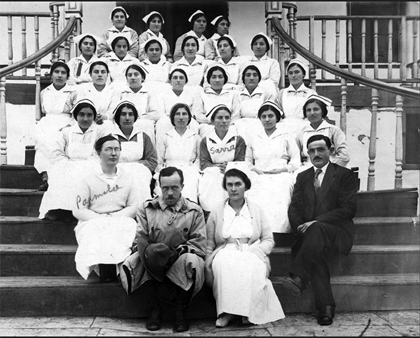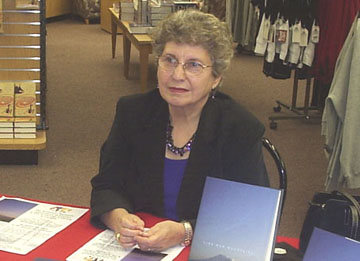A conversation with Professor Isabel Kaprielian-Churchill on the publication of her recent work titled Sisters of Mercy and Survival: Armenian Nurses, 1900-1930 –
A conversation with Professor Isabel Kaprielian-Churchill on the publication of her recent work titled Sisters of Mercy and Survival: Armenian Nurses, 1900-1930 –
A conversation with Professor Isabel Kaprielian-Churchill on the publication of her recent work titled Sisters of Mercy and Survival: Armenian Nurses, 1900-1930. The book focuses on the role of Armenian nurses in Western-run medical institutions in the Ottoman Empire and the Middle East before and after World War I.
Interview by Dania Ohanian
Nurses and staff at the Annie Tracy Riggs Memorial Hospital, Mezireh, 1921
What instigated the project of Sisters of Mercy and Survival?
Originally, I had no intention of writing a book about Armenian nurses. My experience demonstrates how historians can be drawn into a project through sheer curiosity. While working at the Hoover Institution Archives at Stanford University, I inadvertently came across a photograph of a group of Armenian nurses, with their names, taken at the Annie Tracy Riggs/Near East Relief Hospital in Kharpert in 1921. The picture mesmerized me, but at the time I was working on another book and felt I could not allow myself to be distracted by a new undertaking. In time, however, I started doing some research on the nurses and before long, I had plunged into an unknown, fascinating, and gripping world.
What were the major challenges of the compilation and how long did it take you to gather the material?
Sometimes, historians undertake a project when they come across valuable documents in an archive. But in this case, nothing was readily available. Luckily, the American Board of Commissioners for Foreign Missions (ABCFM) has a vast archive at the Houghton Library at Harvard University, much of it in digital format. But there were serious gaps. I did not have access to the Near East Relief (NER) archives and while I knew there could be valuable material in Armenia, using it required a special trip. So I would say that the major challenge was the availability of research material.
As for how long it took me to collect the material, it was stretched out over a period of about eight years. Of course during that time, I did not focus only on this book forsaking everything else. I continued to teach and work on other research and writing.
Professor Isabel Kaprielian-Churchill
Do you think the experience of Armenian nurses emphasizes feminism?
The experience of Armenian nurses emphasizes feminism, but feminism intimately wrapped in a number of other issues. This book represents a complex web of interrelated and overlapping issues. Without going into great detail, let me mention a few of the more prominent forces: competing colonial expansion in the Middle East; Catholic and especially Protestant prosyletization; the Genocide; the treatment of Armenian orphan girls; and the pioneering work of Armenian nurses in laying the foundations of modern nursing in Turkey, Armenia, Greece, and Syria/Lebanon, especially in the fields of midwifery and public health.
As to feminism, the experience of Armenian nurses highlights not the theory of feminism so much as feminism in action. Over a period of several decades, we see the molding of Armenian girls into professional nurses. The issue of professionalism is a key to their role.
At the same time, western professional women – the head nurses, the female physicians, the Red Cross nurses – provided vital role models – feminist role models – for the Armenian girls as to what they, too, could become. The role models, however, might have proven useless and fruitless had it not been for the education, determination, the drive, and the commitment of these young women to make a difference in the world. Bearing in mind that these girls were survivors of the Genocide and could have – might have – felt destroyed, it is to their everlasting credit that they rose above their tragedy and made meaningful contributions to the world of medicine and the health and welfare of their patients.
In your opinion, was the training of young Armenian women linked to western-educated medical personnel?
No doubt about it. Missionary physicians opened their own hospitals, sometimes in distant and isolated parts of the Ottoman Empire. Commendable as this was, these hospitals could not function effectively as modern medical institutions without the help of nurses, including student nurses. At first, the missionaries recruited women from western countries including the United States, Canada, England, Ireland, Scotland, Denmark, Norway, Switzerland, and Germany. But as the hospitals increased in number, patient load, and type of treatment, they required more nursing staff. This led to the recruitment and training of local girls. The missionaries required intelligent, conscientious, educated girls dedicated to helping others. This cohort could be found almost exclusively among Armenian girls.
The advent of modern hospitals and medicine at the turn of the 20th century was a recent innovation in such advanced countries as the United States, Britain, Canada, and Germany and gave nurses a new stature, especially with the writing and training provided by Florence Nightingale and her disciples. Amazingly, this revolution in the role of nursing took root in remote areas of Anatolia before World War I, and this, even before some parts of Western Europe. Such a development was only possible because mass public schooling was spreading throughout historic Armenia, and included large numbers of girls. Their education paved the way for their training as professional nurses.
Why was the topic previously ignored by medical historians?
This question troubled me while I was preparing the book. Some excellent studies have been published about the history of medicine among the Armenians. But the role of modern nursing has been largely ignored. Nurses have always been a sad second cousin to physicians, even though, without the nurses, hospitals could hardly have functioned. Moreover, nursing has traditionally been a field for women, so physicians, being largely men, received the glory, the accolades, and the attention.
I believed it important to place Armenian nurses in the larger picture of nursing in the Mediterranean world and in Armenia but also to show as much as I could, their role in the history of Armenian medicine. I see nursing as an honourable profession, an end in itself, but I also view it as the first step of Armenian women entering more extensively into the field of medicine and pharmacology.
In my estimation, Sisters of Mercy and Survival is an initial step portraying this wonderful saga. I am aware there are many gaps in my book, and I am hopeful that new historians will fill those gaps, build on my work, and bring prestige and stature to a profession that has languished far too long among us.
Did the Armenian Genocide change the traditional attitudes towards nursing?
Prior to the Genocide, many Armenians, like most people in Turkey and in fact, elsewhere, viewed nursing as demeaning work. Imagine, taking care of strangers. Men, at that! They also saw hospitals as places to care for the dying rather than as centres to provide healing. Many families objected to their daughters entering nursing, considering it would ruin their prospects for a good marriage. Not only did they object, they also blocked their daughters from engaging in such dirty and bloody work.
During the war and Genocide, Armenian nurses worked in Turkish hospitals – a tragic irony since they were at the mercy of sexual abuse, even murder, in caring for the soldiers of the enemy, while their own people suffered from lack of medical care.
After the war, Armenian nurses worked in NER hospitals and other hospitals under the jurisdiction of Armenian and non-Armenian agencies. Many of their patients were Armenian soldiers, widows, and orphans. Without the help and care of the nurses, thousands of survivors would surely have died or been left maimed. Patients became dependent on the care they received from the nurses and appreciated the important, crucial work they were carrying on, often at great odds. During the 1920s, nursing was seen not only as acceptable work for women, but also as vital for the survival of the nation.
What documents were used for Sisters of Mercy and Survival?
I used documents from a vast number of archives in many different countries, particularly the United States, Armenia, Lebanon, and Switzerland. I also relied heavily on photographs. In addition to an extensive text, Sisters of Mercy and Survival, uses about 250 photographs to depict the vast experience of Armenian nurses during this critical thirty-year period.
What is your next project?
I am currently working on a study of the Georgetown children.
Sisters of Mercy and Survival: Armenian Nurses, 1900-1930
By Isabel Kaprielian-Churchill
Armenian Catholicosate of Cilicia
“Richard and Tina Carolan” Literary Fund
Antelias, 2012


